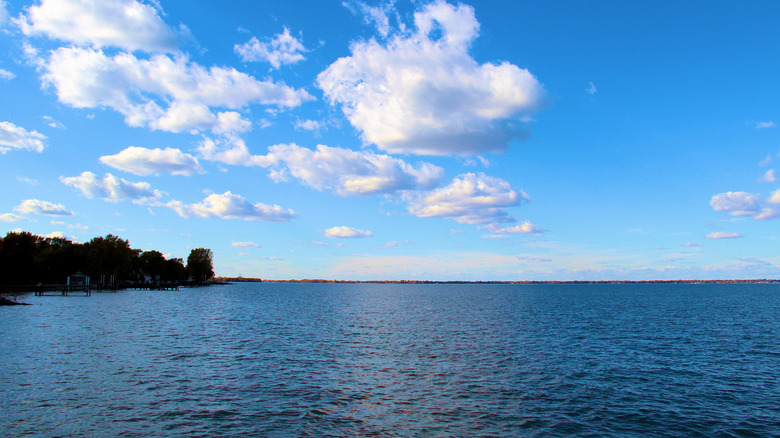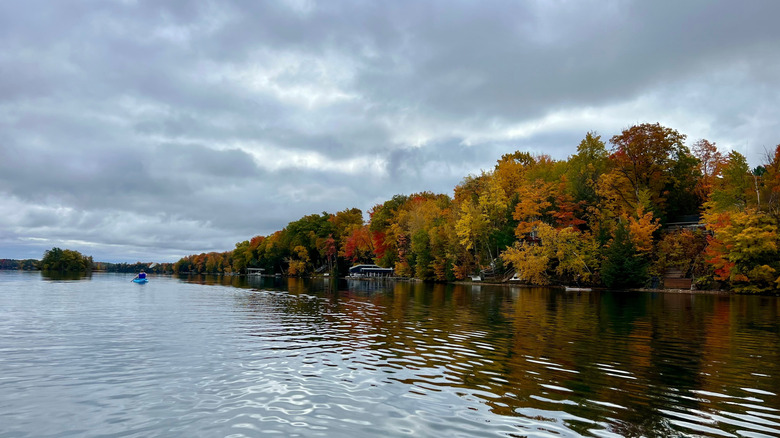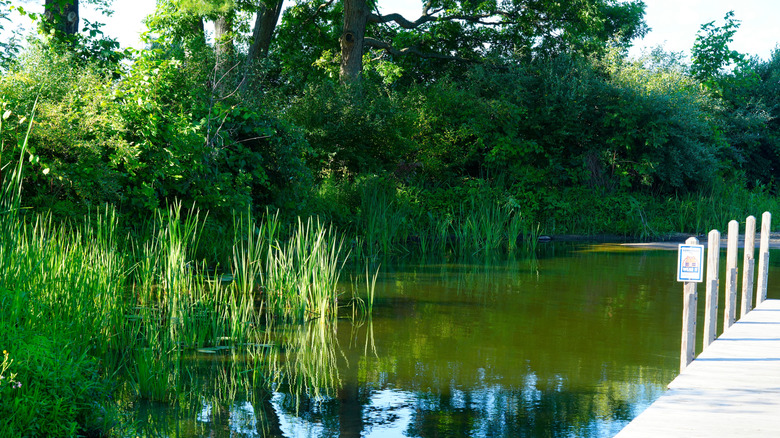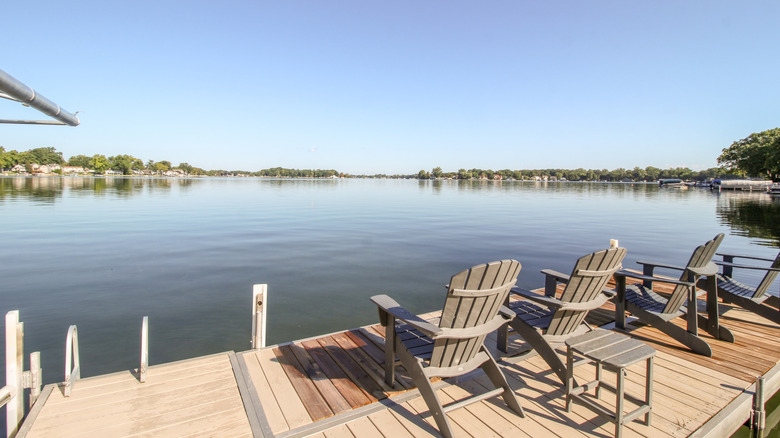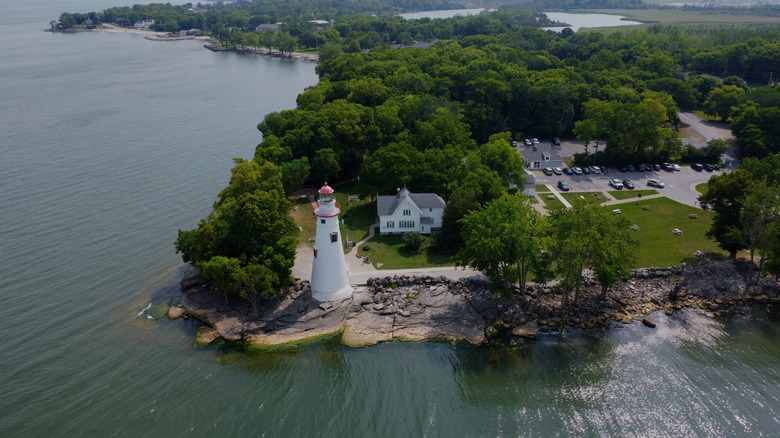These Snake-Filled Lakes In Michigan Should Make You Think Twice Before Swimming
Michigan is renowned for its lakes. Home to the most stunning Great Lakes in the Midwest and gorgeous inland lakes with miles of scenic shoreline, there are plenty of beautiful bodies of water to discover. However, if snakes make you jumpy, there are certain lakes you may want to think twice about before venturing in for a dip. Populated with 18 species of snakes, The Great Lakes State could very well be called The Great Snakes State.
Although only the Eastern massasauga rattlesnake has a deadly bite, swimming with any serpentine creature — venomous or not — may be enough to make your skin crawl. Lurking in warm, shallow waters and slithering through the surrounding wetlands, many waterborne snakes thrive in lakeside habitats. If you're planning a lake-filled getaway in Michigan but would rather avoid a snake-filled getaway, these are a few lakes you should avoid — or at least keep a cautious distance from.
Lake St. Clair
Biting straight into it, the most snake-infested lake in Michigan is Lake St. Clair. Treading the border of Michigan and Ontario, the large lake spans 430 square miles and is revered as the "Heart of the Great Lakes" due to its connection to the Lake Erie basin. Despite its surface area, its depth is on the shallow side. Measuring an average of just 11 feet deep, its warm, shallow waters create the perfect habitat for various snake species, including the northern water snake and eastern garter snake. Both types of snakes are prevalent in the marshy areas surrounding the lake, slithering through the dense vegetation as they hunt for prey. Don't worry; they don't feed on humans — just small fish and amphibians.
You may recognize the eastern garter snake by its common pet name, the "garden snake," which appears in reddish-brown, black, or gray hues with three light stripes running down the length of its medium-sized body (about 3 to 4 feet long). Meanwhile, the northern water snake comes in shades of gray, tan, or brown, wrapped in dark scaly bands, and grows up to 3.5 feet long. Both species are more prevalent in the warmer months and are non-venomous. However, if you get bit, don't fret too hard. The eastern garter snake's bite is as mild as a scratch, and their solitary nature renders them unaggressive unless threatened. Tread more carefully around northern water snakes, which are known to be a bit more aggressive. Their strong jaws inflict an intense bite, drawing a significant amount of blood, and they produce a foul smell from their tail as a defense mechanism.
Long Lake
The northern water snake can also be seen slithering around Long Lake, a popular locale for boating, fishing, and various water sports during the summer months. Covering 4.5 square miles of surface area, the sprawling inland lake is the largest in Grand Traverse County in northern Michigan and significantly deeper than Lake St. Clair (measuring 88 feet at its deepest point). Much like Lake St. Clair, you're likely to encounter the northern water snake in the shallower parts of the water, where warm waters and the aquatic wildlife they feed on are known to thrive.
As long as you stay in the deeper parts of the lake, you should be fine. If you still want something between you and the water for peace of mind, consider renting a boat and taking on a leisurely paddle down the 4-mile lake (after all, they don't call it "long" for nothing). Long Lake Boat Rentals offers a variety of water vessels, including kayaks, pontoon boats, and fishing boats that are ideal for a snake-free day on the lake.
Houghton Lake
You'll encounter several snake species in Michigan's largest inland body of water, Houghton Lake. Though it covers an expansive 20,044 acres, the maximum depth of the monster-sized lake reaches just 20 feet deep. In its shallow waters, you'll find the common northern water snake, eastern garter snake, and the regally-named queen snake.
Medium in size, the slender, semiaquatic queen snakes appear in dark-brown, gray, or olive hues with a pale yellow stripe on each side. Feeding mostly on crayfish (which accounts for 90% of their diet), they inhabit the warm, marshy areas of the lake and live under rocks, which they also bask upon on sunny days. Despite their commanding name, queen snakes are rather shy and not known to be aggressive. As low-risk, non-venomous biters, they're even known to make great house pets.
Lake Fenton
Situated about 67 miles northwest of Detroit – the Midwest spot vying for the title of 'best new art city' thanks to its affordability – is Lake Fenton, a beloved body of water. It is surrounded by charming waterfront homes and teems with water sports enthusiasts during the summer months. As the largest lake in Genesee County (boasting a surface area of 845 acres and reaching up to 90 feet deep), it's also teeming with water snakes.
The northern water snake is the most common, and it feeds on various amphibians, small fish, and crayfish in the lake's shallow waters. Since Lake Fenton is a popular place for fishing — heavily populated by largemouth and smallmouth bass, northern pike, bluegills, pan fish, and many others –- it isn't uncommon for anglers to see aquatic serpents slithering around fishing lines. Just leave some fish for the snakes to feed on, and you're sure to get along just fine.
Lake Erie
The eeriest thing about the picturesque, turquoise-colored Lake Erie is its snake population. In addition to the common northern water snake, the popular Great Lake houses enough serpents to have a snake named after it. A large, thick-bodied reptile, the Lake Erie water snake stretches between 18 and 42 inches long and is typically grayish-green in color with dark brown rings and a white or light yellow underbelly. Similar to the northern water snake, they are non-venomous but can become aggressive if picked up. As a general rule of thumb, don't bother them; they'll give you the same treatment.
While you may want to think twice about swimming in this dangerous U.S. lake, there are plenty of other water activities to enjoy on Lake Erie. Boating is a popular pastime, with the lake's tranquil water easily lending itself to a leisurely afternoon of floating. If you can watch your feet for snakes, paddleboarding is another ideal water sport. Regardless of the creatures slithering beneath the surface, it's perfectly possible to enjoy a serene day on any of Michigan's gorgeous, snake-filled lakes. As long as you're aware and respectful of the aquatic reptiles in their natural habitat, you'll be in for a bite-free retreat.

